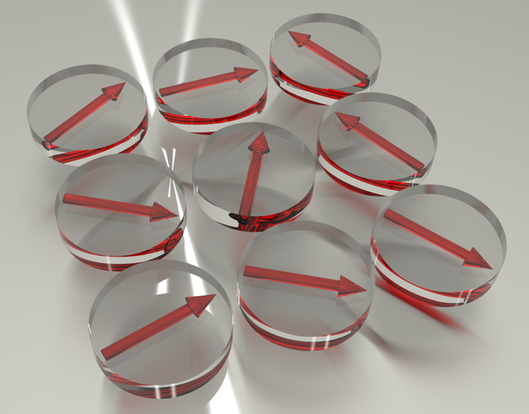Magnetism

Ongoing Research within Magnetism
Magnetism is purely quantum mechanical in its nature. We investigate e.g. fundamental magnetic coupling phenomena, dimensionality aspects of magnetic materials, tailoring of magnetic properties, and some classes of functional magnetic materials.
Depending on the geometrical arrangements of atoms, of one or several species, different types of magnetic ordering will occur. The magnetic interactions, governing the relations between neighbouring magnetic moments throughout the material, depend on the electronic structure. For transition metals where the conduction electrons “cause” magnetism, properties can be tuned through alterations of the electronic structure, e.g. by altering structure or adding a suitable additional element. This addition of elements may both be permanent (alloying or implantation/doping) or reversible (hydrogen absorption and desorption).
Interleaving of two or more distinctive metals in multilayers or superlattices gives additional possibilities for tailoring: a non-magnetic spacer could e.g. mediate parallel or antiparallel magnetic coupling between adjacent magnetic layers, or even isolate them from each other, all depending on the spacer thickness.
Making layers sufficiently thin, we actually reduce the spatial dimensionality of the magnetic material. This affects the fundamental thermodynamics of the magnetic phase transitions, according to universal theories. Effective dimensionality and ordering temperature can be controlled by the thickness of the magnetic layers. Other factors, e.g. crystal structure and spin dimensionality (presence or absence of magnetic anisotropy) determine the fine details.
The artificially structured materials (multilayers, superlattices, arrays of lithography-made islands, etcetera) are also a step towards improved functional magnetic materials. Here, we study mainly magnetic anisotropy, magnetotransport (field-dependent electrical resistance), optical properties and magnetization dynamics of both crystalline and amorphous samples, in close collaboration with other researchers doing predictive calculations.
Contact
- Programme Professor
- Daniel Primetzhofer
- Head of Division
- Gabriella Andersson
- Visiting address: Ångström Laboratory, Lägerhyddsvägen 1, Uppsala, house 4, floor 1 and house 6 floor 1.
